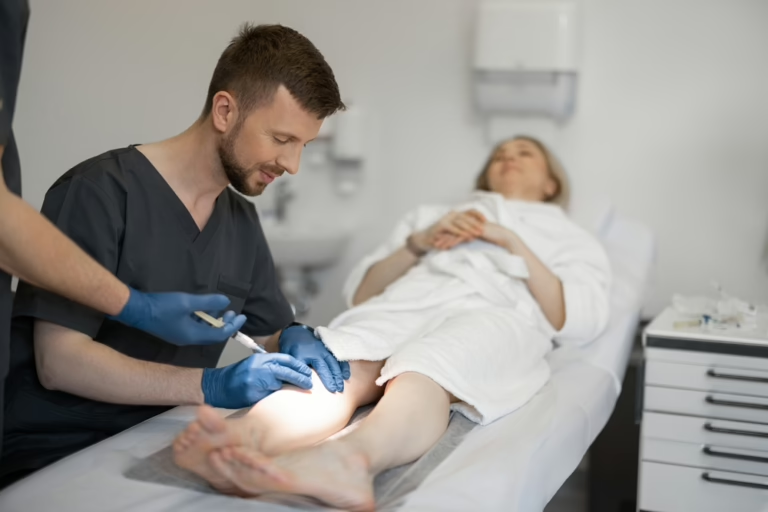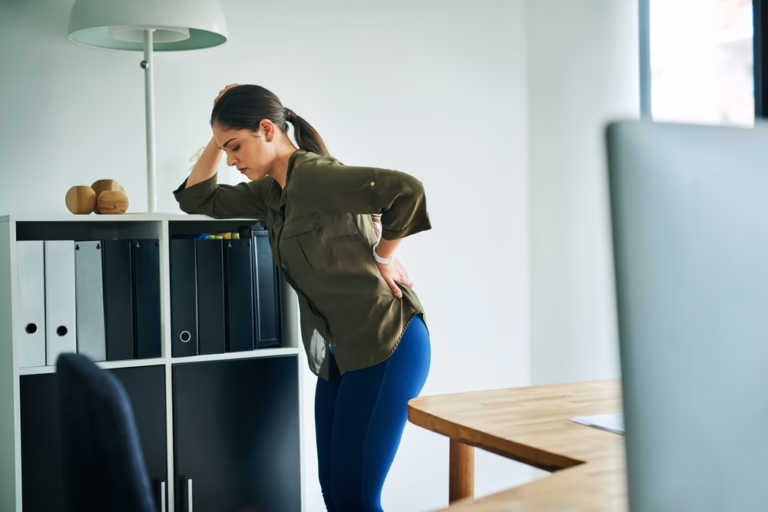You know that feeling when you peel off your shoes after a long day and your legs just ache? Maybe you notice some swelling, or you see those stubborn veins that seem to pop up out of nowhere. If your doctor has ever handed you a pair of compression stockings, you might have wondered, “Are these really going to help?”
Or maybe you’ve heard a few rumors that make you skeptical. Let’s get real about compression therapy: what it is, what it isn’t, and how you can actually make it work for you.
Busting the Biggest Myths About Compression Therapy
Let’s start by clearing the air. There are a lot of myths floating around about compression stockings, and some of them might be holding you back from getting the relief you deserve.
Myth 1: Compression therapy is only for older people.
This is far from the truth. In actuality, people of all ages can benefit from compression therapy. Whether you’re a runner, a teacher on your feet all day, or just someone with a genetic tendency toward vein issues, compression stockings can do wonders.
Myth 2: Compression stockings are painful.
While not implausible, it’s not how they’re intended to function. If your stockings hurt, something’s wrong. They should feel snug but not painful. Discomfort usually means the size or fit isn’t right, so talk to your vein specialist if you’re struggling.
Myth 3: Only people with “bad veins” need them.
Compression therapy isn’t just for those with visible varicose veins. It can help with swelling, fatigue, and even be used preventively if you’re at risk for vein problems.
Myth 4: Compression is only for legs.
As a dedicated vein specialist in Enfield would be quick to point out, legs are certainly the most common area where people suffer varicose and spider veins. However, compression therapy can also be used just as effectively for arms, especially in cases like lymphedema after surgery.
Myth 5: You have to be sedentary to need compression.
Active people, including athletes, use compression to improve circulation, reduce swelling, and recover faster after workouts.
Myth 6: Compression stockings are too hot and uncomfortable.
These aren’t your grandfather’s compression socks. Technology has evolved enough to provide a comfortable fit for all. Today’s stockings come in breathable, moisture-wicking fabrics and a variety of styles, so you don’t have to dread wearing them.
The Science Behind Compression Therapy: Why It Works
So, how do these magical socks actually help? The answer is all about circulation. Compression stockings are designed to apply the most pressure at your ankle, with the pressure gradually decreasing as you move up your leg. This gradient helps push blood back up toward your heart, fighting gravity and preventing blood from pooling in your lower legs.
Here’s what’s happening inside your body when you wear compression stockings:
- Improved Blood Flow: The gentle squeeze supports your veins and helps blood move in the right direction.
- Reduced Swelling: By helping your body reabsorb excess fluid, compression therapy can ease that heavy, achy feeling.
- Prevention of Blood Clots: For those at risk, especially after surgery or long flights, compression can help prevent dangerous clots.
- Support for the Lymphatic System: Compression also helps your body move lymph fluid, which reduces edema and keeps your legs feeling lighter.
- Enhanced Oxygen Delivery: Some studies show that compression can even help get more oxygen to your muscles, which is great for recovery and overall leg health.
Chart: How Compression Therapy Helps
| Benefit | How Compression Therapy Works |
| Improves Circulation | Graduated pressure pushes blood upward |
| Reduces Swelling/Edema | Prevents fluid from pooling in the legs |
| Prevents Blood Clots | Keeps blood moving, especially after surgery |
| Eases Pain and Fatigue | Reduces pressure on veins, relieves discomfort |
| Supports Lymphatic Drainage | Helps move lymph fluid, reducing heaviness |
| Speeds Muscle Recovery | Enhances oxygen delivery and waste removal |
Who Really Needs Compression Therapy After All?
You might be surprised at how many people can benefit from compression stockings. Here are just a few examples:
- People with varicose or spider veins: Compression can ease symptoms and slow progression.
- Those with chronic venous insufficiency: If your veins have trouble sending blood back to your heart, compression is a first-line treatment.
- Anyone recovering from vein procedures or surgery: Stockings help prevent complications and promote healing.
- Pregnant women: Pregnancy increases blood volume and pressure on leg veins, so compression can help reduce swelling and discomfort.
- Travelers: Long flights or car rides can increase your risk for blood clots, so compression is a smart precaution.
- Athletes: Compression can help with recovery and reduce soreness after intense activity.
- People who stand or sit for long periods: Teachers, nurses, retail workers, and office employees all benefit from better circulation.
Making Compression Therapy Work for You: Real-World Tips
If you’re new to compression stockings, you might feel a little overwhelmed. Here’s how to get the most out of your therapy:
Get the Right Fit
Measure your legs first thing in the morning when swelling is at its lowest. Your vein specialist or clinic can help you get the right size.
Put Them On Early
Slip on your stockings before you get out of bed. This helps prevent swelling from starting in the first place.
Smooth Out Wrinkles
Make sure your stockings are smooth and not bunched up. Wrinkles can cause pressure points and discomfort.
Keep Them Clean
Wash your stockings daily with mild soap and air dry them. This keeps them elastic and effective. Having two pairs makes it easier to rotate and always have a clean set ready.
Replace Regularly
Compression stockings lose their effectiveness over time. Plan to replace them every three to six months, or sooner if they feel loose.
Don’t Ignore Discomfort
If your stockings are painful or leave deep marks, talk to your doctor. You may need a different size, style, or level of compression.
Use Aids if Needed
If you have trouble putting them on, try using a stocking donner, rubber gloves, or a little baby powder to help them slide up.
Compression Stockings: Not Just a “One-Size-Fits-All” Solution
There are different levels of compression, measured in millimeters of mercury (mmHg). Your doctor will recommend the right level for your needs:
- Mild (8-15 mmHg): Good for tired, achy legs or mild swelling.
- Moderate (15-20 mmHg): Useful for mild varicose veins, pregnancy, or travel.
- Firm (20-30 mmHg): Often prescribed for moderate to severe varicose veins or after vein procedures.
- Extra firm (30-40 mmHg): Reserved for severe cases and always under medical supervision.
Compression stockings also come in different styles such as knee-high, thigh-high, pantyhose, and even footless options. Your vein clinic can help you choose what’s best for your lifestyle and medical needs.
The Emotional Side: It’s Okay to Feel Self-Conscious
Let’s be honest, compression stockings aren’t always a fashion statement. Some people worry about how they look or feel embarrassed to wear them in public. If that’s you, know you’re not alone. Today’s stockings come in a variety of colors and patterns, and many are designed to look just like regular socks or tights. The most important thing is your health and comfort, so give yourself credit for taking care of your legs.
If you’re struggling with motivation, try setting a small goal like wearing your stockings for a few hours each day and gradually increasing the time. Celebrate your progress, and remember that every step you take is helping your veins and your overall well-being.
When to Call Your Vein Specialist
Compression therapy is safe for most people, but there are a few times when you should check in with your doctor:
- If you notice numbness, tingling, or pain while wearing stockings
- If your skin becomes red, irritated, or develops sores
- If your swelling suddenly gets worse
- If you have trouble putting them on or keeping them up
Your vein specialist can adjust your prescription or recommend a different style or size. At Vanishing Veins, you’ll always get personalized care from a team who understands your concerns and wants you to feel comfortable and confident. We offer a variety of cutting-edge treatments that can pair with your use of compression stockings like spider vein treatment in New Britain, CT and the surrounding areas.
Getting the Most Out of Your Compression Stockings
Compression therapy is more than a simple remedy. It’s scientifically linked to reclaiming comfort, mobility, and confidence. By busting myths, understanding the science, and following a few practical tips, you can make compression therapy a powerful tool in your journey to healthier legs.
If you’re ready to take control of your vein health, reach out to Vanishing Veins. Our compassionate team is here to help you every step of the way, from your first fitting to your follow-up visits. Let’s put your best foot forward together.



